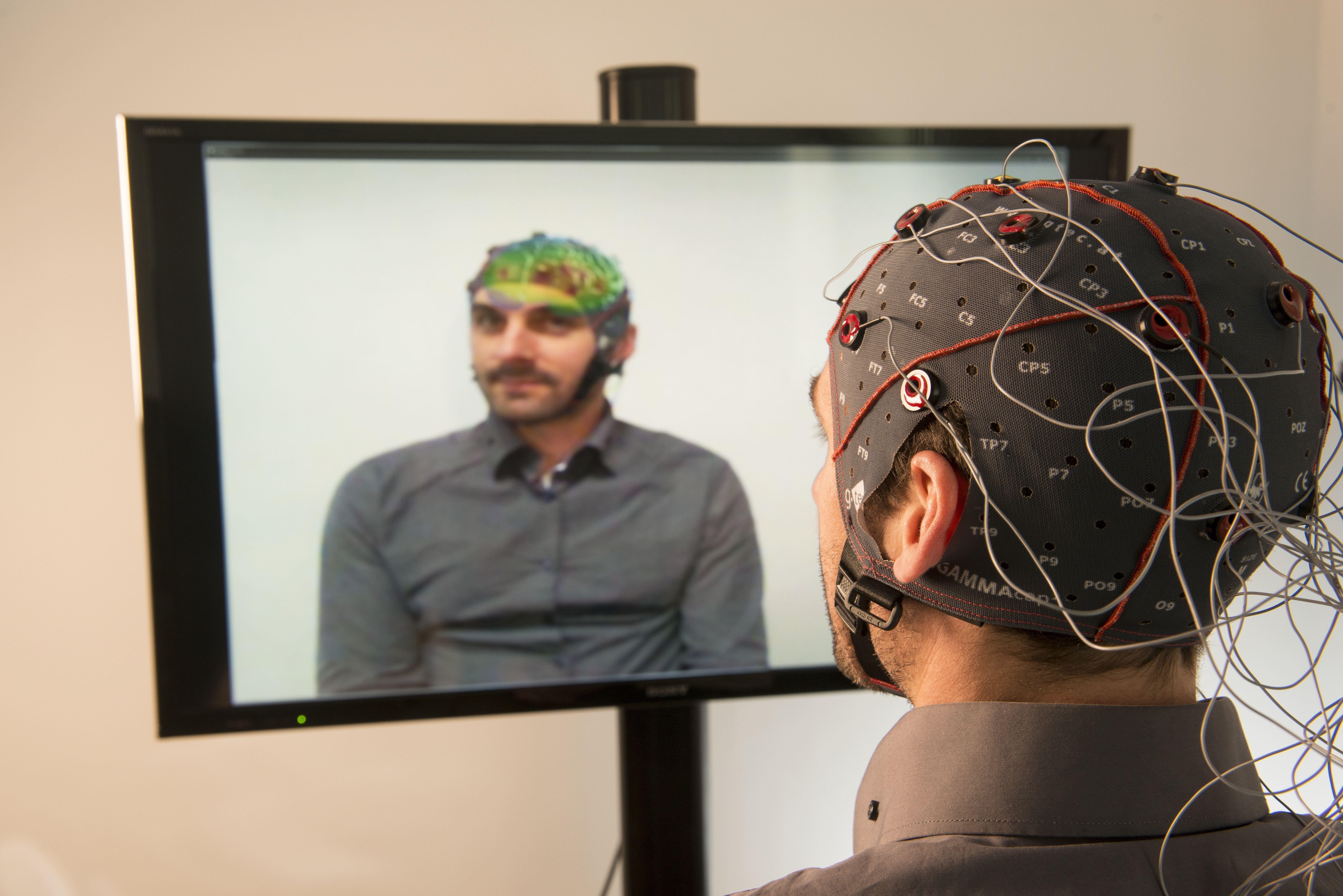Section: New Results
Brain-Computer Interfaces
Novel usages of BCI
Mind-Mirror: combining BCI and augmented reality to "see your brain in action in your own head", Anatole Lécuyer, Jonathan Mercier, Maud Marchal
|
Imagine you are facing a mirror, seeing at the same time both your real body and a virtual display of your brain in activity and perfectly superimposed to your real image “inside your real skull”. We have introduced a novel augmented reality paradigm called “Mind-Mirror” which enables the experience of seeing “through your own head”, visualizing your brain “in action and in situ” [36] . Our approach relies on the use of a semi-transparent mirror positioned in front of a computer screen. A virtual brain is displayed on screen and automatically follows the head movements using an optical face-tracking system. The brain activity is extracted and processed in real-time with the help of an electroencephalography cap (EEG) worn by the user. A rear view is also proposed thanks to an additional webcam recording the rear of the user’s head. The use of EEG classification techniques enables to test a Neurofeedback scenario in which the user can train and progressively learn how to control different mental states, such as “concentrated” versus “relaxed”. The results of a user study comparing a standard visualization used in Neurofeedback to our approach showed that the Mind-Mirror could be successfully used and that the participants have particularly appreciated its innovation and originality. We believe that, in addition to applications in Neurofeedback and Brain-Computer Interfaces, the Mind-Mirror could also be used as a novel visualization tool for education, training or entertainment applications.
This work was achieved in collaboration with Fabien Lotte from POTIOC team (Inria-Bordeaux).
Using SSVEP-based BCI with 3D stereoscopic display Anatole Lécuyer
We have investigated the feasibility of dual-frequency Steady-State Visual Evoked Potential (SSVEP) stimulation using a 3-D display and stereoscopic glasses [44] . Dual-frequency stimulation allows for more targets to be created using a small number of frequencies, and stereoscopic vision offers a suitable medium for dual-frequency stimulation as the two views can be controlled independently. Participants were exposed to a repetitive visual stimulus flashing at different frequencies in the left and right views and the electroencephalography (EEG) trace was examined. Our results suggest that the two stimulation frequencies can still be evident in the SSVEP response. In addition, the participant ratings showed no significant differences in fatigue, annoyance, comfort or strangeness of the stimulation compared to conventional forms of stimulation. These results pave the way for further studies using stereoscopic dual-frequency stimulation and its potential for use in virtual reality and 3D videogames
This work was achieved in collaboration with Robert Leeb (EPFL, Switzerland).
Passive BCI and music Anatole Lécuyer
Passive brain–computer interfaces (passive BCI), also named implicit BCI, provide information from user mental activity to a computerized application without the need for the user to control his brain activity. We have proposed an overview of current research on passive BCIs in [45] . We have notably studied how they can be applied to the context of music creation, where they can provide novel information to adapt the music creation process, e.g., exploiting user mental concentration to adapt the music tempo.
BCI methodology
Which factors drive successful BCI skill learning? Anatole Lécuyer, Lorraine Perronnet
Brain-Computer Interfaces although very promising, suffer from a poor reliability. Rather than improving brain signal-processing alone, an interesting research direction is to guide users to learn BCI control mastery. Thus, we have inroduced a set of motivational and cognitive factors which could influence the learning process, and which should be considered to improve the global performance of BCI users [47] . We base our approach on Keller’s integrative theory of motivation, volition, and performance, which combines motivational (affective) and cognitive factors, to explain what makes human users learn and perform efficiently, irrespectively of the task. These factors can guide the creation of learning environments, such as BCI training protocols.
This work was achieved in collaboration with Fabien Lotte and Christian Muhl (POTIOC team, Inria-Bordeaux), Moritz Grosse-Wentrup (MPI, Tuebingen), and Reinhold Scherer (TU Graz, Austria).
A methodological framework for applications combining BCI and VE Anatole Lécuyer
We have proposed a user-centred methodological framework [46] to guide design and evaluation of applications combining Brain-Computer Interface (BCI) and Virtual Environment (VE). Our framework is based on the contributions of ergonomics to ensure these applications are well suited for end-users. It provides methods, criteria and metrics to perform the phases of the human-centred design process aiming to understand the context of use, specify the user needs and evaluate the solutions in order to define design choices. Several ergonomic methods (e.g., interviews, longitudinal studies, user based testing), objective metrics (e.g., task success, number of errors) and subjective metrics (e.g., mark assigned to an item) are suggested to define and measure the usefulness, usability, acceptability, hedonic qualities, appealingness, emotions related to user experience, immersion and presence to be respected. The benefits and contributions of our user centred framework for the ergonomic design of applications combining BCI and VE were also discussed.
This work was achieved in collaboration with Fabien Lotte from POTIOC team (Inria-Bordeaux).


